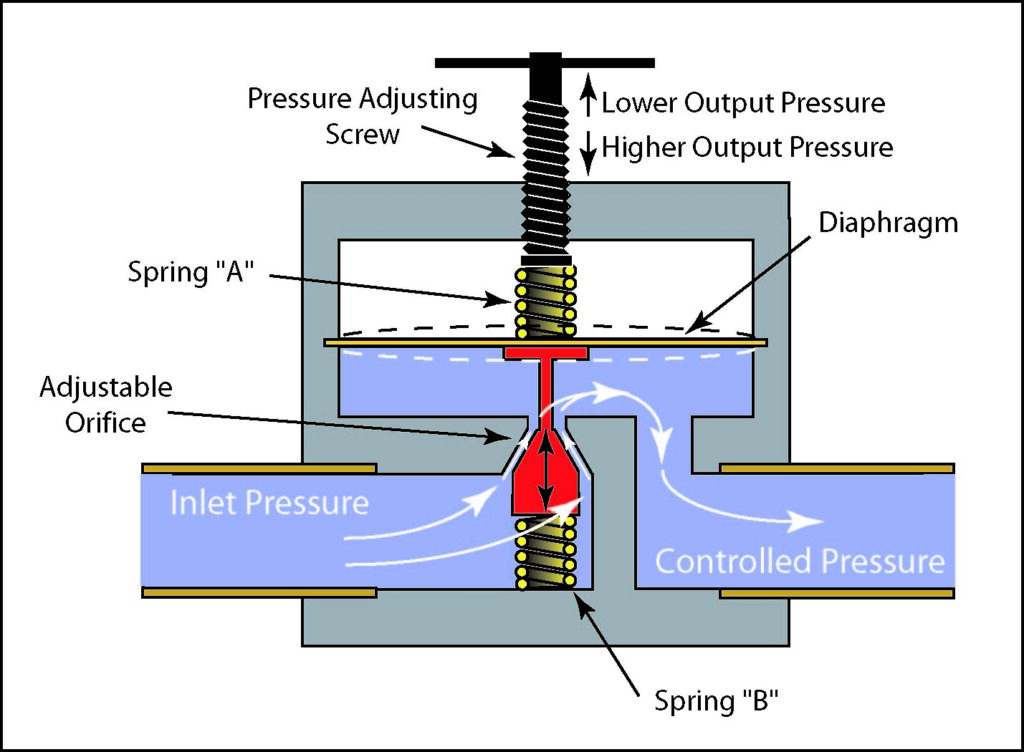It is not an uncommon practice to use flow restricting valves in an effort to reduce and/or control pressure in even the most sophisticated industrial cleaning machines. In the blog “Reducing Flow vs. Reducing Pressure – Which is it?” the risks of using flow restricting valves to control pressure were discussed in some detail. Reliable pressure control can only be provided by pressure reducing valves with a feedback mechanism or back pressure controlling valves. Today’s blog will explain the basic operating features of pressure reducing valves.
In order for a valve to control pressure, it needs to be able to sense the output pressure and adjust an orifice within the valve to maintain the desired pressure. Although there are hundreds (or maybe thousands) of ways this can be done, the following illustration is representative of most of them.

Most of us have seen these little valves with the handle on the top that seems to work backwards from the way we think it should. But, have you ever really thought about what goes on inside? Liquid (or gas) under pressure enters the valve through the inlet port. It then goes through an adjustable orifice which is designed to have the minimum possible response to forward pressure (or else pressure on the inlet side of the valve would tend to hold the valve closed under high inlet pressure conditions). Once the liquid passes through the orifice, it goes into a chamber, one wall of which is a diaphragm which is attached directly to the moving part of the adjustable orifice valve. The diaphragm moves in response to the pressure on the outlet side of the adjustable orifice valve. Two springs are used to temper the motion of the diaphragm and the attached moving part of the valve. Spring “A” at the top in the above illustration transmits pressure from the adjusting screw to the diaphragm and moving valve component. Spring “B” at the bottom in the above illustration counteracts the movement of the diaphragm and the moving valve component. As the pressure in the chamber behind the diaphragm increases, the diaphragm moves upward to reduce the size of the orifice thereby restricting flow and reducing the outlet pressure. In the opposite case, reduced pressure allows the diaphragm to move downward enlarging the orifice and increasing flow to increase outlet pressure. The adjusting screw at the top adjusts the balance between springs “A” and “B” to balance the diaphragm as required to produce the desired outlet pressure.

Discover Aquarius™, the ultimate solution where ultrasonic technology meets efficiency in a tank-to-tank cleaning system.
This scheme has been used for centuries to reliably reduce pressure of liquids and gasses. Even with no flow, the pressure on the outlet side of the valve is maintained (unlike the examples using fixed orifices in the previous blog). Another type of valve, a “back-pressure” valve may also be used to maintain pressure in some instances. The back-pressure valve and some of its potential uses will be described in the next blog.
– FJF –

 Water – De-ionized – Hints
Water – De-ionized – Hints  A Fond Farewell to John Fuchs
A Fond Farewell to John Fuchs  Millipore Testing – Evaluation by Particle Counting
Millipore Testing – Evaluation by Particle Counting  Tape Test for Cleaning Revisited
Tape Test for Cleaning Revisited